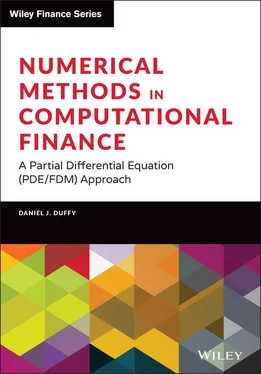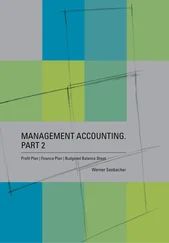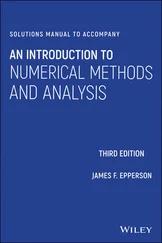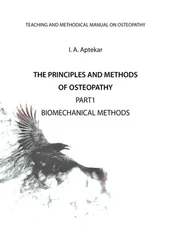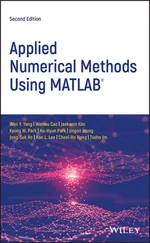1 Cover
2 Title Page Numerical Methods in Computational Finance A Partial Differential Equation (PDE/FDM) Approach DANIEL J. DUFFY
3 Copyright This edition first published 2022 Copyright © 2022 by John Wiley & Sons, Ltd. Registered office John Wiley & Sons Ltd, The Atrium, Southern Gate, Chichester, West Sussex, PO19 8SQ, United Kingdom For details of our global editorial offices, for customer services and for information about how to apply for permission to reuse the copyright material in this book please see our website at www.wiley.com . All rights reserved. No part of this publication may be reproduced, stored in a retrieval system, or transmitted, in any form or by any means, electronic, mechanical, photocopying, recording or otherwise, except as permitted by the UK Copyright, Designs and Patents Act 1988, without the prior permission of the publisher. Wiley publishes in a variety of print and electronic formats and by print-on-demand. Some material included with standard print versions of this book may not be included in e-books or in print-on-demand. If this book refers to media such as a CD or DVD that is not included in the version you purchased, you may download this material at http://booksupport.wiley.com . For more information about Wiley products, visit www.wiley.com . Designations used by companies to distinguish their products are often claimed as trademarks. All brand names and product names used in this book are trade names, service marks, trademarks or registered trademarks of their respective owners. The publisher is not associated with any product or vendor mentioned in this book. Limit of Liability/Disclaimer of Warranty: While the publisher and author have used their best efforts in preparing this book, they make no representations or warranties with respect to the accuracy or completeness of the contents of this book and specifically disclaim any implied warranties of merchantability or fitness for a particular purpose. It is sold on the understanding that the publisher is not engaged in rendering professional services and neither the publisher nor the author shall be liable for damages arising here from. If professional advice or other expert assistance is required, the services of a competent professional should be sought. Library of Congress Cataloging-in-Publication Data is Available: ISBN 9781119719670 (Hardback) ISBN 9781119719724 (ePub) ISBN 9781119719694 (ePDF) Cover Design: Wiley Cover Image: © windesign/Shutterstock
4 Preface
5 Who Should Read this Book?
6 PART A: Mathematical Foundation for One-Factor Problems CHAPTER 1: Real Analysis Foundations for this Book 1.1 INTRODUCTION AND OBJECTIVES 1.2 CONTINUOUS FUNCTIONS 1.3 DIFFERENTIAL CALCULUS 1.4 PARTIAL DERIVATIVES 1.5 FUNCTIONS AND IMPLICIT FORMS 1.6 METRIC SPACES AND CAUCHY SEQUENCES 1.7 SUMMARY AND CONCLUSIONS CHAPTER 2: Ordinary Differential Equations (ODEs), Part 1 2.1 INTRODUCTION AND OBJECTIVES 2.2 BACKGROUND AND PROBLEM STATEMENT 2.3 DISCRETISATION OF INITIAL VALUE PROBLEMS: FUNDAMENTALS 2.4 SPECIAL SCHEMES 2.5 FOUNDATIONS OF DISCRETE TIME APPROXIMATIONS 2.6 STIFF ODEs 2.7 INTERMEZZO: EXPLICIT SOLUTIONS 2.8 SUMMARY AND CONCLUSIONS CHAPTER 3: Ordinary Differential Equations (ODEs), Part 2 3.1 INTRODUCTION AND OBJECTIVES 3.2 EXISTENCE AND UNIQUENESS RESULTS 3.3 OTHER MODEL EXAMPLES 3.4 EXISTENCE THEOREMS FOR STOCHASTIC DIFFERENTIAL EQUATIONS (SDEs) 3.5 NUMERICAL METHODS FOR ODES 3.6 THE RICCATI EQUATION 3.7 MATRIX DIFFERENTIAL EQUATIONS 3.8 SUMMARY AND CONCLUSIONS CHAPTER 4: An Introduction to Finite Dimensional Vector Spaces 4.1 SHORT INTRODUCTION AND OBJECTIVES 4.2 WHAT IS A VECTOR SPACE? 4.3 SUBSPACES 4.4 LINEAR INDEPENDENCE AND BASES 4.5 LINEAR TRANSFORMATIONS 4.6 SUMMARY AND CONCLUSIONS CHAPTER 5: Guide to Matrix Theory and Numerical Linear Algebra 5.1 INTRODUCTION AND OBJECTIVES 5.2 FROM VECTOR SPACES TO MATRICES 5.3 INNER PRODUCT SPACES 5.4 FROM VECTOR SPACES TO MATRICES 5.5 FUNDAMENTAL MATRIX PROPERTIES 5.6 ESSENTIAL MATRIX TYPES 5.7 THE CAYLEY TRANSFORM 5.8 SUMMARY AND CONCLUSIONS CHAPTER 6: Numerical Solutions of Boundary Value Problems 6.1 INTRODUCTION AND OBJECTIVES 6.2 AN INTRODUCTION TO NUMERICAL LINEAR ALGEBRA 6.3 DIRECT METHODS FOR LINEAR SYSTEMS 6.4 SOLVING TRIDIAGONAL SYSTEMS 6.5 TWO-POINT BOUNDARY VALUE PROBLEMS 6.6 ITERATIVE MATRIX SOLVERS 6.7 EXAMPLE: ITERATIVE SOLVERS FOR ELLIPTIC PDEs 6.8 SUMMARY AND CONCLUSIONS CHAPTER 7: Black–Scholes Finite Differences for the Impatient 7.1 INTRODUCTION AND OBJECTIVES 7.2 THE BLACK–SCHOLES EQUATION: FULLY IMPLICIT AND CRANK–NICOLSON METHODS 7.3 THE BLACK–SCHOLES EQUATION: TRINOMIAL METHOD 7.4 THE HEAT EQUATION AND ALTERNATING DIRECTION EXPLICIT (ADE) METHOD 7.5 ADE FOR BLACK–SCHOLES: SOME TEST RESULTS 7.6 SUMMARY AND CONCLUSIONS
7 PART B: Mathematical Foundation for Two-Factor Problems CHAPTER 8: Classifying and Transforming Partial Differential Equations 8.1 INTRODUCTION AND OBJECTIVES 8.2 BACKGROUND AND PROBLEM STATEMENT 8.3 INTRODUCTION TO ELLIPTIC EQUATIONS 8.4 CLASSIFICATION OF SECOND-ORDER EQUATIONS 8.5 EXAMPLES OF TWO-FACTOR MODELS FROM COMPUTATIONAL FINANCE 8.6 SUMMARY AND CONCLUSIONS CHAPTER 9: Transforming Partial Differential Equations to a Bounded Domain 9.1 INTRODUCTION AND OBJECTIVES 9.2 THE DOMAIN IN WHICH A PDE IS DEFINED: PREAMBLE 9.3 OTHER EXAMPLES 9.4 HOTSPOTS 9.5 WHAT HAPPENED TO DOMAIN TRUNCATION? 9.6 ANOTHER WAY TO REMOVE MIXED DERIVATIVE TERMS 9.7 SUMMARY AND CONCLUSIONS CHAPTER 10: Boundary Value Problems for Elliptic and Parabolic Partial Differential Equations 10.1 INTRODUCTION AND OBJECTIVES 10.2 NOTATION AND PREREQUISITES 10.3 THE LAPLACE EQUATION 10.4 PROPERTIES OF THE LAPLACE EQUATION 10.5 SOME ELLIPTIC BOUNDARY VALUE PROBLEMS 10.6 EXTENDED MAXIMUM-MINIMUM PRINCIPLES 10.7 SUMMARY AND CONCLUSIONS CHAPTER 11: Fichera Theory, Energy Inequalities and Integral Relations 11.1 INTRODUCTION AND OBJECTIVES 11.2 BACKGROUND AND PROBLEM STATEMENT 11.3 WELL-POSED PROBLEMS AND ENERGY ESTIMATES 11.4 THE FICHERA THEORY: OVERVIEW 11.5 THE FICHERA THEORY: THE CORE BUSINESS 11.6 THE FICHERA THEORY: FURTHER EXAMPLES AND APPLICATIONS 11.7 SOME USEFUL THEOREMS 11.8 SUMMARY AND CONCLUSIONS CHAPTER 12: An Introduction to Time-Dependent Partial Differential Equations 12.1 INTRODUCTION AND OBJECTIVES 12.2 NOTATION AND PREREQUISITES 12.3 PREAMBLE: SEPARATION OF VARIABLES FOR THE HEAT EQUATION 12.4 WELL-POSED PROBLEMS 12.5 VARIATIONS ON INITIAL BOUNDARY VALUE PROBLEM FOR THE HEAT EQUATION 12.6 MAXIMUM-MINIMUM PRINCIPLES FOR PARABOLIC PDES 12.7 PARABOLIC EQUATIONS WITH TIME-DEPENDENT BOUNDARIES 12.8 UNIQUENESS THEOREMS FOR BOUNDARY VALUE PROBLEMS IN TWO DIMENSIONS 12.9 SUMMARY AND CONCLUSIONS CHAPTER 13: Stochastics Representations of PDEs and Applications 13.1 INTRODUCTION AND OBJECTIVES 13.2 BACKGROUND, REQUIREMENTS AND PROBLEM STATEMENT 13.3 AN OVERVIEW OF STOCHASTIC DIFFERENTIAL EQUATIONS (SDEs) 13.4 AN INTRODUCTION TO ONE-DIMENSIONAL RANDOM PROCESSES 13.5 AN INTRODUCTION TO THE NUMERICAL APPROXIMATION OF SDEs 13.6 PATH EVOLUTION AND MONTE CARLO OPTION PRICING 13.7 TWO-FACTOR PROBLEMS 13.8 THE ITO FORMULA 13.9 STOCHASTICS MEETS PDEs 13.10 FIRST EXIT-TIME PROBLEMS 13.11 SUMMARY AND CONCLUSIONS
8 PART C: The Foundations of the Finite Difference Method (FDM) CHAPTER 14: Mathematical and Numerical Foundations of the Finite Difference Method, Part I 14.1 INTRODUCTION AND OBJECTIVES 14.2 NOTATION AND PREREQUISITES 14.3 WHAT IS THE FINITE DIFFERENCE METHOD, REALLY? 14.4 FOURIER ANALYSIS OF LINEAR PDES 14.5 DISCRETE FOURIER TRANSFORM 14.6 THEORETICAL CONSIDERATIONS 14.7 FIRST-ORDER PARTIAL DIFFERENTIAL EQUATIONS 14.8 SUMMARY AND CONCLUSIONS CHAPTER 15: Mathematical and Numerical Foundations of the Finite Difference Method, Part II 15.1 INTRODUCTION AND OBJECTIVES 15.2 A SHORT HISTORY OF NUMERICAL METHODS FOR CDR EQUATIONS 15.3 EXPONENTIAL FITTING AND TIME-DEPENDENT CONVECTION-DIFFUSION 15.4 STABILITY AND CONVERGENCE ANALYSIS 15.5 SPECIAL LIMITING CASES 15.6 STABILITY FOR INITIAL BOUNDARY VALUE PROBLEMS 15.7 SEMI-DISCRETISATION FOR CONVECTION-DIFFUSION PROBLEMS 15.8 PADÉ MATRIX APPROXIMATION 15.9 TIME-DEPENDENT CONVECTION-DIFFUSION EQUATIONS 15.10 SUMMARY AND CONCLUSIONS CHAPTER 16: Sensitivity Analysis, Option Greeks and Parameter Optimisation, Part I 16.1 INTRODUCTION AND OBJECTIVES 16.2 HELICOPTER VIEW OF SENSITIVITY ANALYSIS 16.3 BLACK–SCHOLES–MERTON GREEKS 16.4 DIVIDED DIFFERENCES 16.5 CUBIC SPLINE INTERPOLATION 16.6 SOME COMPLEX FUNCTION THEORY 16.7 THE COMPLEX STEP METHOD (CSM) 16.8 SUMMARY AND CONCLUSIONS CHAPTER 17: Advanced Topics in Sensitivity Analysis 17.1 INTRODUCTION AND OBJECTIVES 17.2 EXAMPLES OF CSE 17.3 CSE AND BLACK–SCHOLES PDE 17.4 USING OPERATOR CALCULUS TO COMPUTE GREEKS 17.5 AN INTRODUCTION TO AUTOMATIC DIFFERENTIATION (AD) FOR THE IMPATIENT 17.6 DUAL NUMBERS 17.7 AUTOMATIC DIFFERENTIATION IN C++ 17.8 SUMMARY AND CONCLUSIONS
Читать дальше
